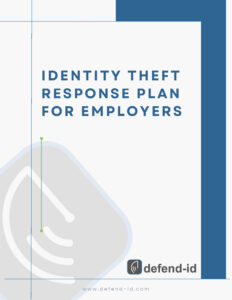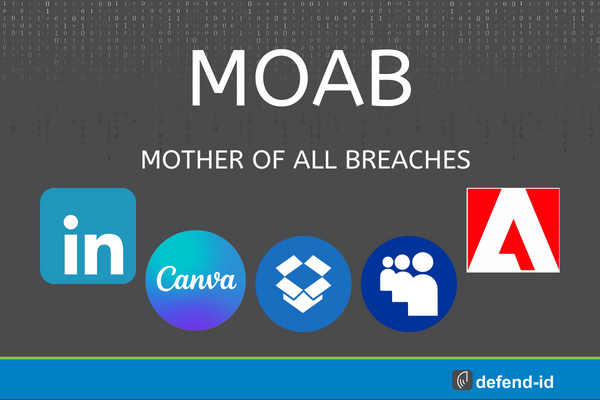
by Brian Thompson | Feb 7, 2024 | Employee Benefits, Identity Theft
Personal information is as valuable as currency, so protecting oneself from identity theft is crucial. With cybercriminals becoming increasingly sophisticated, simply hoping for the best is like leaving your front door wide open. But with so many identity theft protection services out there, how do you pick the right lock and camera for your digital doorway? This guide isn’t just about How to Choose the Best Identity Theft Protection Service for You.
Imagine walking through Times Square, your wallet visibly bulging with cash. In the digital world, that’s exactly what you’re doing without proper identity theft protection. This guide is about sifting through the vast and sometimes murky waters of online security Marketing. There are some apples and orange scenarios but it’s usually a variation of the orange you need to be aware of.
The Essentials of Identity Theft Protection
At its core, identity theft protection monitors personal information in credit reports, public records, and online spaces to alert you of potential fraud. Services range from basic credit monitoring to robust plans including fraud resolution support and up to $1 million in identity theft insurance. Yet, as cyber threats evolve, so should our defenses. Comprehensive digital security tools like antivirus software, VPNs, and password managers are becoming indispensable in the fight against identity theft.
Evaluating Your Needs
Before diving into the sea of services, take a step back and assess your digital footprint. Are you a casual internet user or a digital nomad living online? Do you frequently shop or bank online? Understanding your habits and exposure can help pinpoint what protections are most pertinent. Ask yourself what scares you more: the thought of someone opening a credit card in your name or the realization that your personal photos and conversations could be leaked? This introspection is your compass in choosing the right service.
Comparing Services: Beyond the Brand
In the world of identity theft protection, differentiation is often muddled by similar marketing promises, making everything appear equally effective. However, this uniformity is a facade. Many insurance carriers, for example, tout “identity theft protection” as part of their offerings, but a closer look may reveal a watered-down version of protection. These versions often lack comprehensive monitoring, digital security tools, and robust fraud resolution services, focusing instead on post-theft insurance without preventative measures. It’s a bit like offering an umbrella that can only be opened once the rain has stopped – helpful, but not quite what you need when the storm hits.
This highlights the importance of digging deeper than flashy marketing. True protection encompasses both mitigation and resolution, offering protection before the attack and a place to turn if needed. When evaluating services, ask pointed questions about the specifics of their monitoring capabilities, the extent of their insurance coverage, and how they support you in fraud resolution. Remember, when it comes to safeguarding your identity, the quality matters.
Big names might catch your eye, but the devil’s in the details. Look past the logo to what’s actually on offer. Some services excel at credit monitoring but skimp on digital security measures. It’s akin to having a state-of-the-art lock on a flimsy door. Dive deep into what each plan covers, and scrutinize the fine print for what matters most to you.
Key Features to Look For
Here’s a checklist for your quest:
- Credit and Identity Monitoring: How thorough is the monitoring? Is it just your credit score, or does it include dark web surveillance and social media?
- Fraud Resolution and Insurance: What happens if your identity is stolen? Look for services offering hands-on support in restoring your identity, along with substantial insurance coverage.
- Digital Security Tools: Comprehensive protection isn’t just about monitoring; it’s also about prevention. Services that include or offer discounts on antivirus software, VPNs, and password managers are gold.
- Customer Support: When panic strikes, responsive customer service can be your calming beacon. Ensure the service offers 24/7 support.
Making the Decision on How to Choose the Best Identity Theft Protection Service for You
Balancing cost against features can feel like a high-wire act. Remember, free plans might be tempting, but the level of protection is often proportional to the investment. AND – nothing is free. Think of it as insurance: you’re not just paying for the service but for peace of mind. Take advantage of free trials and money-back guarantees to test the waters before committing.
Your Safety, Your Choice
In the end, choosing the right identity theft protection service boils down to understanding your digital lifestyle and matching it with a service that covers your bases without breaking the bank. It’s about finding that perfect balance between peace of mind and practicality. Remember, in the digital world, your security is your responsibility, but you don’t have to go it alone.
FAQs
- Q: Can identity theft protection services prevent all types of identity theft?
A: While no service can offer a 100% guarantee, a comprehensive protection plan significantly reduces your risk and provides tools and support to minimize the impact should identity theft occur.
- Q: How often should I review my identity theft protection needs?
A: As your digital life evolves, so should your protection. Review your coverage annually or after major life changes, like moving, marriage, or a change in online habits.
- Q: Are digital security tools like antivirus and VPNs really necessary?
A: Absolutely. In today’s interconnected world, these tools form the first line of defense against cybercriminals, protecting your personal information from being compromised in the first place.
Additional Thoughts
In a world brimming with digital threats, choosing the right identity theft protection service is more than a convenience—it’s a necessity. Arm yourself with knowledge, and make the choice that best fits your digital footprint. After all, in the fight against identity theft, being proactive isn’t just smart; it’s essential.
Protecting Your Employees, Too:
 Employers, it’s your responsibility to protect not just your business but also your employees from identity theft. That’s why we’ve created the Employer Identity Theft Plan. This comprehensive guide provides valuable strategies and steps to take if an employee’s identity is stolen.
Employers, it’s your responsibility to protect not just your business but also your employees from identity theft. That’s why we’ve created the Employer Identity Theft Plan. This comprehensive guide provides valuable strategies and steps to take if an employee’s identity is stolen.
Download the Plan Now to ensure you’re prepared to assist your employees in protecting their identities. Equip yourself with the knowledge and resources to handle such incidents effectively and maintain a secure workplace environment.
Articles related to How to Choose the Best Identity Theft Protection Service for You:

by Brian Thompson | Jan 31, 2024 | Breach, Identity Theft
Businesses and organizations take note! The “Mother Of All Breaches,” involving an unprecedented 26 billion records, isn’t just a personal concern; it’s a corporate crisis. This breach, compromising data from major platforms, poses serious risks to both individual users and organizations. Dive into our mother of all breaches business data security tips.
Understanding the Breach: A Business Perspective
This isn’t just about leaked emails and passwords. The “Mother Of All Breaches” is a complex aggregation of multiple incidents, presenting a unique challenge for businesses. The breach’s vast scope means sensitive employee data could be at risk, leading to potential identity theft or financial fraud. Companies need to recognize the gravity of the situation and act swiftly to safeguard their data and support their employees.
Mother Of All Breaches business data security tips – Immediate Actions
For Employers: Ensure your team is aware of the breach. Encourage them to use tools like Have I Been Pwned to check their data status. For accounts with compromised credentials, enforce immediate password changes. Emphasize the necessity of unique passwords and the adoption of two-factor authentication across all work-related platforms.
Password Strength: A strong password is a blend of letters (both uppercase and lowercase), numbers, and symbols. For example, ‘Coffee_Mug123!’ is better than ‘coffee123’. Avoid using easily guessable information like birthdays or common words.
Long-Term Data Security Strategies
A robust approach to password management is non-negotiable. Encourage the use of password managers for generating and storing complex passwords. Regularly monitor company accounts for unusual activities and educate your employees on recognizing phishing attempts and other cyber threats.
Broader Implications for Companies
Responsibility: It’s not just about technical defenses; it’s about a culture of cybersecurity awareness. Regular training sessions and updates on data security policies are essential. Businesses must also stay abreast of global data protection regulations to ensure compliance and safeguard against breaches.
Securing Our Digital Future
The “Mother Of All Breaches” is a wake-up call for businesses and individuals alike. It’s a reminder that in our interconnected digital world, the responsibility for data security is shared. By fostering a culture of cybersecurity mindfulness and implementing proactive strategies, we can safeguard our collective digital future.
FAQs for Businesses:
- What are the first steps a company should take after a breach?Immediately check if company or employee data is involved, enforce password updates, and review security protocols.
- How can businesses educate their employees about cybersecurity? Regular training sessions, updates on cybersecurity best practices, and encouraging a culture of vigilance are key.
- What are the long-term implications of such breaches for businesses? Potential risks include reputational damage, financial losses, and legal implications due to non-compliance with data protection laws.
Articles/linkes related to mother of all breaches business data security tips:

by Brian Thompson | Dec 6, 2023 | Identity Theft
The holiday season is upon us, and with it comes a joyous flurry of shopping, gifting, and festive cheer. But amidst the twinkling lights and carols lurks a potential Grinch: identity theft. This year, protect your holiday spirit and your finances with this essential guide to holiday shopping identity theft protection.
Beware the Online Shopping Wolves:
Imagine finding the perfect gift online, only to discover it’s a trap! Online shopping scams are the reigning champions of holiday fraud, disguised as fake marketplaces and shady payment methods. Don’t fall for those tempting “too-good-to-be-true” deals – they’re often bait for unsuspecting shoppers.
Fortify Your Digital Kingdom:
Your passwords are the keys to your online castle. Treat them like precious treasure. Craft unique, complex passwords for every account, especially those linked to your finances. And don’t forget two-factor authentication – it’s like having a digital bodyguard keeping watch over your information.
Unmask the Silent Data Snatchers:
Ever heard of skimming? These tiny devices, planted on ATMs and card readers, silently steal your card information. Be vigilant! Choose contactless payment options whenever possible, and keep an eye on your surroundings when using public card readers.
Avoid the Hacker’s Playground:
Public Wi-Fi might seem convenient, but it’s also a haven for hackers. Avoid using public Wi-Fi for shopping or accessing sensitive information. Remember, convenience shouldn’t come at the cost of security.
Don’t Trust the Wolves in Sheep’s Clothing:
Scammers are masters of disguise, often posing as legitimate job opportunities or charitable organizations. Always double-check the authenticity of any request before donating or applying for work. Remember, if something sounds too good to be true, it probably is.
Consumer Concerns: A Holiday Shopping Reality Check:
A whopping three-quarters of you worry about data breaches while holiday shopping, and with good reason. The number of concerned shoppers is at an all-time high. It’s not just paranoia – it’s a necessary precaution in today’s digital world.
Transform Yourself into a Security Ninja:
Become a savvy shopper with these essential tips:
- Verify online stores and charities before clicking.
- Use secure payment methods like credit cards with strong fraud protection.
- Monitor your account statements regularly – early detection is key.
Holiday Cheer without the Fear:
Don’t let the fear of identity theft dampen your holiday spirit. By following these simple guidelines, you can navigate the holiday shopping maze with confidence and joy. Remember, awareness is your best defense. So, stay vigilant, stay safe, and enjoy a scam-free holiday season!
Spread the Word:
Share this guide with your loved ones and help them protect themselves from holiday scams. For more financial fitness tips, subscribe to our blog.
Let’s toast to a happy, safe, and scam-free holiday season!
Articles related to holiday shopping identity theft protection

by Brian Thompson | Nov 15, 2023 | Identity Theft
The excitement of Black Friday is just around the corner, and while it’s a great time to score amazing deals, it’s also a time when cybercriminals are particularly active, preying on unsuspecting shoppers. This comprehensive guide will equip you with the knowledge and tools to safeguard your personal information and enjoy a secure Black Friday shopping experience. B
1. Beware of Phishing Scams: Identify and Avoid Malicious Emails
Phishing scams are a common tactic used to trick unsuspecting individuals into revealing sensitive information, such as passwords, credit card details, or Social Security numbers. These emails often masquerade as legitimate communications from well-known companies or organizations, making them difficult to spot.
Here are some red flags to watch out for to identify phishing scams:
-
Account Verification Scams: Emails claiming a need to update your account information due to a hacking attempt or other security breach are likely phishing attempts. Genuine companies will never ask for sensitive details via email.
-
Order Confirmation and Billing Error Scams: Be cautious of emails about unexplained orders or billing issues. These emails often lead to fraudulent sites designed to steal your credit card information.
-
Delivery Scams: Ignore texts or emails with fake delivery notices or tracking numbers. These scams aim to lure you into clicking on malicious links or downloading malware.
2. Spotting Legitimate Deals: Exercise Caution and Verify Authenticity
In the frenzy of Black Friday sales, it’s easy to fall prey to scams. Here are some tips to spot genuine deals and avoid fraudulent ones:
-
Too Good To Be True: If a deal appears unrealistically low, it probably is. Exercise caution and verify the deal’s authenticity by checking the retailer’s official website or contacting their customer service team.
-
Personal Information Requests: Genuine companies will never ask for sensitive details, such as passwords or credit card information, through insecure means like email. If you receive such a request, it’s a clear indication of a scam.
-
Website Security: Ensure the website you’re shopping on uses encrypted connections, indicated by “https://” and a padlock symbol in the address bar. This ensures that your data is transmitted securely and protected from eavesdropping.
3. Utilizing Trusted Security Tools: Fortify Your Online Defense
Technology can be a powerful ally in safeguarding your identity online. Here are some essential security tools to consider incorporating into your online shopping routine:
-
Strong Security Software: Opt for reputable antivirus and anti-malware software to protect your device from malicious software and ransomware. Keep your software up to date to ensure the latest protection against evolving threats.
-
Virtual Private Networks (VPNs): Hide your IP address and location for secure browsing and prevent cyber criminals from tracking your online activity. This is especially useful when using public Wi-Fi networks, which are often unsecured.
-
Password Managers: Use tools that help you create and manage strong, unique passwords for each online account. Never reuse passwords across different sites, as this makes you more vulnerable to credential-stuffing attacks.
-
Ad Blockers: Employ ad blockers to avoid malicious pop-ups, scripts, and third-party tracking cookies. These can not only be annoying but can also potentially expose you to malware or redirect you to fraudulent sites.
-
Mobile Security Apps: Protect your smartphone from phishing sites and ensure secure online transactions, especially when shopping on the go. Many mobile security apps offer real-time protection and can block suspicious websites or prevent malicious downloads.
4. Immediate Actions if Compromised: Swift Response to Protect Your Identity
If you suspect your identity has been compromised, take immediate action to minimize the potential damage and protect your financial accounts:
-
Contact Your Bank: Immediately report any unauthorized transactions on your bank accounts or credit cards to prevent further losses. This will also allow your bank to take steps to protect your account and investigate the fraudulent activity.
-
Report to Authorities: Notify fraud reporting centers and law enforcement, especially if you believe your identity has been stolen for fraudulent purposes. This will help in tracking down the perpetrators and preventing future scams.
Stay Vigilant and Shop Securely
Black Friday is an excellent opportunity to find amazing deals, but it’s also a prime target for cybercriminals. By staying alert, employing these strategies, and utilizing the right security tools, you can enjoy the shopping spree without compromising your identity. Remember, the key to safe shopping is vigilance, caution, and the right use of technology.
Related Articles:

by Brian Thompson | Nov 10, 2023 | Identity Theft
As someone who holds our military community in high esteem, I’ve been reflecting on a critical issue we face- identity theft. This isn’t just a civilian problem—it’s a significant concern for our active duty personnel, veterans, and their families. Our national heroes are trained to be battle-ready for any threat to national security. Yet, there’s a front that often gets overlooked – Securing the Home Front: Identity Theft in the Military
Understanding the Risks
A surprising reality: Did you know that as military members, we’re at a heightened risk for identity theft? Reports suggest that nearly 50,000 military consumers have faced this challenge head-on. And it’s not just about the numbers; the consequences of stolen identity can ripple through our lives, causing financial and personal turmoil.
The Vulnerability of Our Forces
- Relocations and Deployments: Our service often requires us to pack up and move, sometimes at a moment’s notice. Each move is an opportunity for personal information to fall into the wrong hands, especially when we’re stationed overseas and focused on the mission at hand.
- A Culture of Trust: We rely on a shared bond of trust, a cornerstone of military cohesion. Unfortunately, scammers exploit this trust, posing as fellow service members or veterans to phish for sensitive information.
How to Fortify Your Defenses
We’re no strangers to defense strategies, but the tactics differ when it’s about protecting our identities:
- Shredding documents: Before you toss out those orders or reports, shred them. It’s your first line of defense.
- Credit monitoring: Make it a routine – check your credit reports regularly, just as you would maintain your gear.
- Vigilance with personal info: Train yourself to detect scams. If someone asks for personal information over the phone or email, verify their credentials first.
- Strong password protocols: Create passwords as robust as a fortified base. No simple ‘password123’ for us, right?
- Active duty alerts: Just like setting a perimeter, these alerts put a barrier between your credit and potential fraudsters while you serve.
Implementing Active Duty Alerts
Protecting your credit with active duty alerts is akin to having a watch guard for your finances. Here’s how to set it:
- Reach out to one of the three major credit bureaus – Equifax, Experian, or TransUnion. It’s like choosing which guard post to fortify.
- Confirm your identity with solid proof. This process is as essential as verifying clearance for a secured area.
- Initiate the alert, which signals the bureaus to step up their guard and verify any credit requests in your name carefully.
- Renew as required: Just like renewing your duty station orders, keep the alert active to match the length of your deployment.
Your Call to Action
Your financial safety is part of operational security. By staying vigilant, you protect not just yourself but also the integrity of our forces. Keep your personal information locked down, stay alert for signs of breaches, and spread the word. We’re in this fight together – let’s make sure we’re all armed and ready.
Identity theft in the military is prevalent…Stay safe and secure, both on and off the field.
Related Articles:

by Brian Thompson | Nov 8, 2023 | Identity Theft
In today’s hyperconnected world, technology has become an indispensable part of our lives, seamlessly weaving its way into our daily routines. From online banking and shopping to social media interactions and entertainment, technology has revolutionized the way we communicate, work, and engage with the world around us. However, this interconnectedness also brings with it a heightened risk to our personal information, making us vulnerable to identity theft. Identity theft protection in the digital age is something we all should be aware of.
The Double-Edged Sword of Technology: A Balancing Act of Protection and Exposure
Technology plays a dual role in our identity protection: it both shields and exposes our personal information. On the one hand, secure online banking platforms, encrypted communication channels, and password authentication mechanisms help safeguard our financial and sensitive data. Social media platforms, while not entirely secure, allow us to connect with friends and family, share experiences, and stay informed.
However, this same technology can also be exploited by cybercriminals to steal our identities. Phishing scams, malicious software, and data breaches are just a few examples of how criminals capitalize on the convenience and ubiquity of technology to infiltrate our digital lives.
The Evolving Landscape of Identity Theft: Staying Ahead of the Curve
 The methods used by identity thieves are constantly evolving, adapting to advancements in technology and our changing online habits. Phishing scams, once relying on deceptive emails, have become more sophisticated, impersonating legitimate websites and using social engineering techniques to trick users into revealing personal information.
The methods used by identity thieves are constantly evolving, adapting to advancements in technology and our changing online habits. Phishing scams, once relying on deceptive emails, have become more sophisticated, impersonating legitimate websites and using social engineering techniques to trick users into revealing personal information.
Malware attacks, which can infect our devices through malicious links or attachments, can steal data, install spyware, and even lock us out of our devices, demanding ransom payments. Data breaches, often caused by inadequate security measures or human error, can expose millions of personal records, leaving individuals vulnerable to identity theft.
Advanced Identity Theft Prevention Technologies: Leveraging Technology for Your Protection
Fortunately, technological advancements also offer solutions for mitigating identity theft risks. Facial recognition software, when implemented securely, can verify identities and reduce the likelihood of impersonation. Data encryption scrambles sensitive information, making it unreadable to unauthorized individuals. Tokenization replaces sensitive data with unique identifiers, further protecting it from theft.
Practical Tips for Navigating the Digital Labyrinth: Strategies to Safeguard Your Identity
In the digital age, vigilance and proactive measures are essential for protecting our identities. Here are some practical tips to navigate the online world safely:
- Be selective about personal information shared online. Avoid sharing sensitive information like your Social Security number, birth date, or financial account details on social media platforms or public forums.
- Create strong and unique passwords for all your online accounts. Avoid using easily guessable information like birthdays or common words. Consider using a password manager to securely store and manage your passwords.
- Enable multi-factor authentication (MFA) on all your important accounts. MFA adds an extra layer of security by requiring a verification code from your mobile device or email in addition to your password.
- Regularly update your security software and operating systems. Security patches and updates address vulnerabilities that hackers can exploit.
- Be cautious of suspicious emails, links, and attachments. Phishing scams often use these tactics to trick you into revealing personal information or clicking on malicious links.
- Regularly conduct cybersecurity audits of your devices and accounts. Check for unusual activity, suspicious login attempts, or unauthorized charges.
Identity theft can have a devastating impact on individuals, not just financially, but also emotionally and psychologically. The stress, anxiety, and fear associated with identity theft can lead to depression, sleep disturbances, and even post-traumatic stress disorder (PTSD).
The emotional scars of identity theft can linger long after the financial damage is repaired. Victims may struggle with trust issues, a fear of online transactions, and a constant vigilance for signs of further identity theft.
The Power of Individual Responsibility
While technology plays a role in identity theft, individuals have the power to safeguard their identities through their online behavior and security practices. By emphasizing this responsibility, we empower readers to take proactive steps to protect themselves.
Be sure to:
- Create a strong password policy and implement MFA on all accounts.
- Regularly review financial statements and credit reports for unauthorized activity.
- Protect your personal devices with strong passwords, anti-virus software, and firewalls.
- Be cautious of what personal information you share online.
- Educate yourself about identity theft prevention strategies.
By taking these steps, individuals can significantly reduce their risk of becoming victims of identity theft and safeguard their personal information in the digital world. Identity theft protection in the digital age is a real and relevant concern.
Related Articles:
Follow us on LinkedIn

 Employers, it’s your responsibility to protect not just your business but also your employees from identity theft. That’s why we’ve created the Employer Identity Theft Plan. This comprehensive guide provides valuable strategies and steps to take if an employee’s identity is stolen.
Employers, it’s your responsibility to protect not just your business but also your employees from identity theft. That’s why we’ve created the Employer Identity Theft Plan. This comprehensive guide provides valuable strategies and steps to take if an employee’s identity is stolen.




 The methods used by identity thieves are constantly evolving, adapting to advancements in technology and our changing online habits. Phishing scams, once relying on deceptive emails, have become more sophisticated, impersonating legitimate websites and using social engineering techniques to trick users into revealing personal information.
The methods used by identity thieves are constantly evolving, adapting to advancements in technology and our changing online habits. Phishing scams, once relying on deceptive emails, have become more sophisticated, impersonating legitimate websites and using social engineering techniques to trick users into revealing personal information.